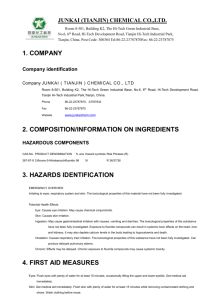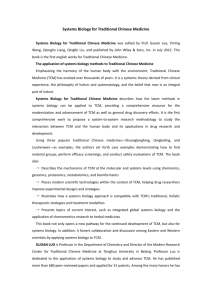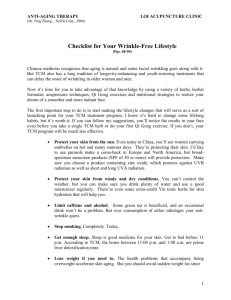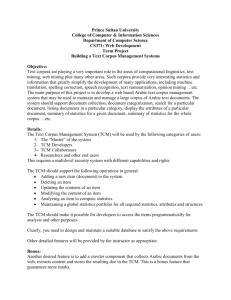《风力发电科技发展“十二五”专项规划》
advertisement
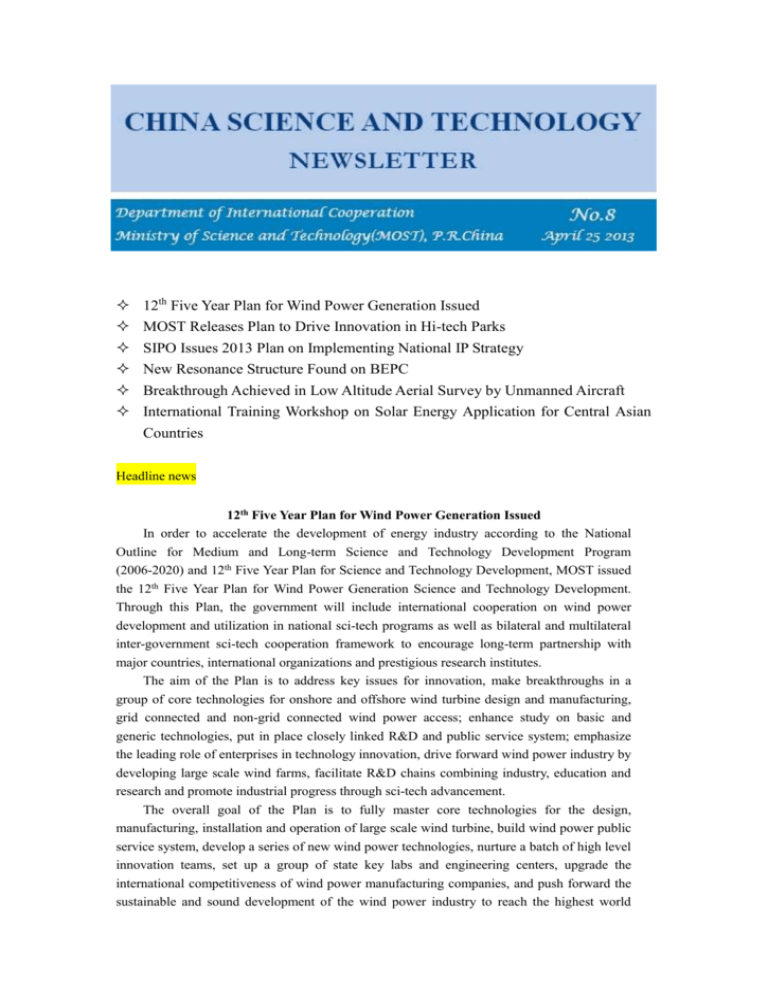
12th Five Year Plan for Wind Power Generation Issued MOST Releases Plan to Drive Innovation in Hi-tech Parks SIPO Issues 2013 Plan on Implementing National IP Strategy New Resonance Structure Found on BEPC Breakthrough Achieved in Low Altitude Aerial Survey by Unmanned Aircraft International Training Workshop on Solar Energy Application for Central Asian Countries Headline news 12th Five Year Plan for Wind Power Generation Issued In order to accelerate the development of energy industry according to the National Outline for Medium and Long-term Science and Technology Development Program (2006-2020) and 12th Five Year Plan for Science and Technology Development, MOST issued the 12th Five Year Plan for Wind Power Generation Science and Technology Development. Through this Plan, the government will include international cooperation on wind power development and utilization in national sci-tech programs as well as bilateral and multilateral inter-government sci-tech cooperation framework to encourage long-term partnership with major countries, international organizations and prestigious research institutes. The aim of the Plan is to address key issues for innovation, make breakthroughs in a group of core technologies for onshore and offshore wind turbine design and manufacturing, grid connected and non-grid connected wind power access; enhance study on basic and generic technologies, put in place closely linked R&D and public service system; emphasize the leading role of enterprises in technology innovation, drive forward wind power industry by developing large scale wind farms, facilitate R&D chains combining industry, education and research and promote industrial progress through sci-tech advancement. The overall goal of the Plan is to fully master core technologies for the design, manufacturing, installation and operation of large scale wind turbine, build wind power public service system, develop a series of new wind power technologies, nurture a batch of high level innovation teams, set up a group of state key labs and engineering centers, upgrade the international competitiveness of wind power manufacturing companies, and push forward the sustainable and sound development of the wind power industry to reach the highest world standard. (Source: MOST) S&T Management Information MOST Releases Plan to Drive Innovation in Hi-tech Parks To implement the tasks set by the State Council’s Guideline for Deepening Reform on Sci-tech System and Accelerating the Development of National Innovation System and the National Conference on Science, Technology & Innovation, MOST released an implementation plan to realize innovation-driven strategy in national hi-tech development zones. The plan has mapped out 4 leapfrog development for national hi-tech parks: from self-development to innovation and strategic leading, from resource allocation based on regional and intensive development to an industrial structure based on global integrated innovation, from resource and enterprise intensive industrial bases to innovation driven industrial clusters with international competitiveness and influence, and from industrial economy oriented parks to those which integrate knowledge economy, innovation, ecological progress as well as hi-tech advancement. It is pointed out in the plan that the overarching goal is to build national hi-tech parks into strategic heights for innovation, core carriers for the development of strategic emerging industries, engines for economic restructuring, pioneers for innovation and sci-tech progress as well as the frontier for hi-tech development, thus making full use of the innovation demonstration zones and hi-tech parks in building innovation-driven country. The six major tasks of the plan include: developing new mechanisms conducive to the integration of sci-tech and socio-economic development; building a technology innovation system with enterprises as the main players; accelerating the growth of emerging industries; improving innovation service system; creating better social conditions for innovation; and upgrading sci-tech progress. (Source: MOST, March 21, 2013) SIPO Issues 2013 Plan on Implementing National IP Strategy This plan is promulgated by SIPO to implement the requirements of the 18th National Congress of the Communist Party of China (CPC), carry out the innovation-driven development strategy, and realize the five-year goals set in the Outline of the National Intellectual Property Strategy. The plan identifies eight tasks and 84 measures for 2013. I. Enhancing Intellectual Property (IP) Creation Goals: Raising the quality of intellectual property rights (IPRs) and innovation efficiency; improving the relevant examination management, i.e, patent, trademark, copyright, new plant varieties, etc., improving the IP performance evaluation system, encouraging the IP creators to transfer their focus from the quantity to the quality; and upgrading the IP value. II. Strengthening IP Layout in Key Industries Goals: Promoting the integration of IP and industrial policies, strengthening the IP risk assessment and warning in strategic emerging industries and industries with regional advantages, reinforcing the guidance to the IP layout in key industries, guiding the industries and enterprises to enhance their capacities of leveraging IPRs in global competition. III. Promoting IP Utilization Goals: Strengthening the key role by enterprises in IP utilization, improving the transformation and commercialization mechanism for IP-linked and IP-based innovations, implementing the policies facilitating IP transformation and the transfer to enterprises, promoting the materialization, commercialization and industrialization of IP rights. IV. Reinforcing IP Protection Goals: Refining IP-related laws and regulations, improving the long-term mechanism of combating IP infringement according to the law, implementing the performance evaluation of IP protection. Enhancing the effectiveness of judicial IPR protection and the capacity of administrative enforcement, implementing the special protection operations and assistance programs for key fields and industries, promoting the information disclosure of IP cases subject to administrative penalty. Strengthening the protection of IP resources in the fields with traditional advantages, enhancing the ability of dealing with international cases. V. Improving IP Management Capacity Goals: Developing policies to strengthen IP management, improving IP management system and coordination mechanism, stepping up collaborative, regulatory, and proactive management of IP, improving IP management efficiency, enhancing the capacity and level of scientific IP management by various stakeholders. VI. Developing IP Service Industry Goals: Improving the management system of IP service industry by implementing related policies, strengthening the construction and utilization of the fundamental IP information resource, guiding IP service agencies to expand business, training high-end IP service talents, cultivating and promoting the development of IP service industry. VII. Strengthening IP Culture Development Goals: Strengthening the dissemination of IP knowledge, the training of personnel, the inclusion of IP in school education, fostering an IP culture that respects knowledge, advocates innovation, integrity and law, strengthening the supportive role of IP in the development of cultural industries, providing support to the integration and development of IP in major fields like press, radio, film and television, literature and art, and promoting cultural industries. VIII. Improving the Organization and Implementation of IP Strategy Goals: Realizing the five-year goals set in the Outline of the National Intellectual Property Strategy, strengthening the working system and platform for the implementation of IP strategy, conducting comprehensive assessment of the five-year goals, carrying out evaluation and selection of the best performers in implementing the national IP strategy, convening conference on promoting the IP strategy and holding special publicity activities,and promoting overall work of IP strategy deepening. (Source: State Intellectual Property Office, March 21, 2013) Scientific Research Progress and Achievements New Resonance Structure Found on BEPC On March 26, the international cooperation group that works with Spectrometer III, the main detector for Beijing Electron-Positron Collider (BEPC) announced the finding of a new resonance structure, tentatively named Zc (3900). The quark mesons at charm energy district generally contain charm quarks and anti-charm quarks. They are neutral and uncharged, called the charmonium. The newly discovered Zc (3900) contains a charm quark and anti-charm quark with the same or opposite electronic charge. With at least four quarks, the particle might be an exotic hadron that scientists have long looked for. The spokesman of BESIII international cooperation group Shen Xiaoyan said it had always been a goal for his team to look beyond traditional quark model of hadron state. The discovery of charged Zc (3900) is likely to open a door for searching and studying of new hadron state. Nearly 300 scientists from 11 countries participated in the experiment. Its mass is a bit larger than that of a helium atom, and its lifetime is very short. It decays to a charged π meson or a J/ψ meson in only 10-23 seconds. This is different from the ordinary mesotron state. Although scientists still have no idea about its spin and parity quantum number, the process of its decay or origin, they are certain about the existence of exotic hadron. The discovery is of great significance to quantitatively understanding the composition of hadron and the theory of strong interaction. The BESIII experiment will continue with collection of data. It is predicted that the experiment group might get 4 times more data to help scientists better understand Zc (3900). Moreover, the BESIII experiment could help study physics in the charmonium energy region. The findings of the experiment could provide important reference and calibration to study the theory of strong interaction. The experiment group hopes to fully understand a series of new charmonium and charmonium-like particles, and confirm the existence of exotic hadron through the discovery of Zc (3900). (Source: Science and Technology Daily, March 27, 2013) Breakthrough Achieved in Low Altitude Aerial Survey by Unmanned Aircraft The compact and wide-angle composite aerial camera, developed by the Chinese Academy of Surveying & Mapping, and its use for low altitude UAV aerial survey has won the second prize of 2012 national award for technological invention. The prize was presented at the National Conference on Science & Technology Awards on January 18, 2013. Since the wide-angle aerial cameras of international brands are all over 100kg and cannot be used on low altitude and light load unmanned crafts, the Chinese Academy of Surveying & Mapping developed “self-calibrating and self-stabilizing wide angle composite imaging technology”. The aerial camera based on this new technology is only 15kg with 90 degree angular field of view. The camera is successfully installed on unmanned crafts and airships to get high resolution colored images for mapping and geological monitoring as well as silhouette of buildings for 3D modeling. For aerial surveying within 1000m altitude (or 200-300m in cloudy or hazy weather), this new system outweighs the manned crafts loaded with international brand cameras to provide clearer images in a timely manner. (Source: Science & Technology Daily, January 20, 2013) Chinese Scientists Lead in Completing the Draft Wheat A-Genome Sequence The paper on wheat A-genome sequencing was published by Nature online on March 24. For the very first time, the draft wheat A-gemone sequencing was completed, which is valuable for more detailed study of structural and functional genomics of wheat and its genetic improvement. This study was initiated by the wheat research team from State Key Laboratory of Plant Cell and Chromosome Engineering of the Insitute of Genetics and Developmental Biology, Chinese Academy of Sciences, and was conducted in collaboration with BGI-Shenzhen and UC Davis. By adopting new-generation sequencing technology, the team has performed the sequencing, assembly, annotation and analysis of the genome of G1812 series of diploid Triticum urartu. The study has identified 34,879 protein-coding genes and, by comparing them with the genome of known grass family crops, discovered 3,425 A-genome specific genes and 24 new small RNA. It has also found marked increase of disease-resistant genes, which include NB-ARC domains, in A genome. Through comparative analysis of homologous genes, the study has also identified agronomically important genes. In addition, a large number of molecular markers have been screenend out, which will facilitate cloning and genomic selection of agronomically important genes and thus molecular breeding of the wheat. Experts point out that this study will offer a new perspective on the research of wheat's domesticiation, and provide a diploid reference for analysis of polyploid wheat genomes. Annotated genetic information and molecular markers will boost genetic improvement of wheat, and is important in ensuring food security and sustainable development of agriculture. (Source: Science and Technology Daily, March 25, 2013) Direct-writing of Nano-functional Devices on Single-layer Graphene Oxide Achieved by China Researchers from Hefei National Laboratory for Physical Sciences at the Microscale (HFNL), China University of Science and Technology, have demonstrated a new technique of direct writing nano-transistor devices on single-layer graphene oxide (GO) through controlling an atomic force microscope (AFM) tip-induced highly-localized reduction reaction. This achievement was recently published on Nature Communications online. Professor Wang Xiaoping and Professor Luo Yi 's groups for quantum control study of HFNL, has directly made conducting nanopatterns, transistors and interconnecting circuits on insulating GO through localized reduction reaction. In the presence of hydrogen, through controlling the Pt-coated AFM tip-induced local catalysis, researchers have heated GO to 100℃to generate reduced GO (rGO) nanoribbons with the width down to 20 nm and the conductivity over 104 S/m, 1 million times that of graphene oxide. By using this approach, they have also demonstrated interconnected nano-circuits and field effect transistor devices, with performance far superior to the commonly used conductive polymers and amorphous-silicon field effect transistors. According to experts, this technology can be used for direct-writing nano-circuits. As the width of circuit line is controllable and the fabrication requirement is low, and it is seamlessly compatible with existing microelectronics processing technology, it is expected to facilitate the graphene nano-devices, circuits and integration and their application. (Source: Science and Tehcnology Daily, November 25, 2012) "Blue Sky": China's First Hydrogen Fuel Cell Locomotive In January 2013, China's first hydrogen fuel cell locomotive with 150-KW power capacity, developed by Southwest Jiaotong University through 4 years' efforts, was successfully put into operation on the university's dedicated railway line. This vehicle, with multiple technology breakthroughs in fuel cell and permanent magnet synchronous motor in high-power environment, can be widely applied for engineering operation, servicing and shunting in rail transport. Dubbed "Blue Sky", the vehicle is equipped with 150-KW fuel cell as its traction power and two 120-KW permanent magnet synchronous motors. With a designed speed of 65 km/hour, sustained traction of 20 kilonewtons and towing weight of 200 tons, the vehicle, with light load, can operate 24 hours in a row once filled with hydrogen. Accoridng to Professor Chen Weirong, project leader and Deputy Director-General of National Rail Electrification and Automation Engineering Center of the university (the Center), this "Blue Sky"project is financed by National Natural Science Foundation of China (NSFC) and a research focus of the university. The approach is to generate electrical energy through chemical reaction of hydrogen and oxygen, which powers high-power permanent magnet motors, and represents a breakthrough in control system integration, fuel cell, and permanent magnet synchronous motor in high-power environment. As the co-product is water and no harmful gas is emitted, the vehicle is particularly suitable for use in closed environment, such as in subways, tunnels and mines. Based upon that, the Center will continue to develop hydrogen- and battery-powered hybrid vehicles, and put them into commercial operation at an early date. (Source: Science and Technology Daily, January 31, 2013) Cooperation Projects and Channels International Science and Technology Cooperation Base(9): China-Italy Joint Lab on TCM To modernize Traditional Chinese Medicine (TCM), encourage TCM to go international, and facilitate the growth of traditional medicine in China and Italy, the Chinese Ministry of Science and Technology (MOST) and the Italian Ministry of Health launched a joint lab on TCM in November, 2006. The lab provides a platform for exchange and cooperation between universities, research institutes and enterprises. The Chinese partners include Tianjin University of Traditional Chinese Medicine (coordinator), Tianjin Institute of Pharmaceutical Research, Tianjin Zhongxin Pharmaceutical Group, Tasly Pharmaceutical, Tianjin Center for Quality Testing of TCM, and Tianjin International Joint Academy of Biotechnology and Medicine. The Italian partners include Italian National Institute of Health (coordinator), Lazio Regional Health Authority, Faculty of Medicine with the University of Milan, University of Florence, Sigma-tau, Aboca, and Paracelsus Research Society. Under the governmental support and strong teamwork, the joint lab made achievements in academic exchanges, infrastructure construction, joint projects, and personnel training over the past five years. In 2008, the lab was certified to be a national center of international joint study by MOST and State Administration of Foreign Experts Affairs. Identified as an international cooperation base for TCM by State Administration of TCM, the joint lab has become a high-level platform for international cooperation. The lab has received five research grants from MOST and two from Tianjin Municipal Science and Technology Commission, with a total amount of 11.64 million Yuan. The two sides have been engaged in 11 joint projects, such as "Application of modern preparation technology in Chinese medicine", "Treatment of climacteric myocardial ischemia with phytoestrogen-based TCM ", "Research and development of new drug Y101 against hepatitis B", "Acupuncture helps ease adverse effects of chemotherapy" and "Clinical study of stroke rehabilitation through TCM". These projects are proceeding smoothly, with 8 patent applications and 40 papers, including 20 SCI papers. 13 postgraduate students have graduated from the lab and four Chinese researchers have gone to Italy for joint study. Contact:Zhang Deqin Tel:+86-22-59596152 E-mail: huliminth@126.com International Training Workshop on Solar Energy Application for Central Asian Countries May, 2013 Urumqi, China Working Language:Russian Objectives: The aim is to help the participants from Central Asian countries know the technology of China’s solar energy development, small electric equipment in using solar energy; to advance cooperation in utilization of small equipment of solar energy between China and Central Asian countries; to promote advanced solar energy technology in neighboring developing countries. Organizer: Xinjiang Central Asian Center of Science and Economy Information Address: No. 40-8 South Beijing Road, Urumqi, Xinjiang, P.R. China Postcode: 830011 Coordinator: Nie Shuling Tel:+86-991-3680743 Fax:+86-991-3844304 E-mail: niesl8@gmail.ru International Training Workshop on S&T Policies and Management June, 2013 Beijing/Shanghai, China Working Language:English Objectives: The aim is to strengthen inter-governmental exchange between China and other developing countries; to introduce and share S&T, innovation policies and management experience; to promote S&T and economic cooperation between China and other developing countries; and to deal with many global challenges. Organizer: China Science and Technology Exchange Center/Shanghai Training Center, MOST, P. R. China Address: No. 54, Sanlihe Road, Xicheng District, Beijing, P. R. China Postcode:100045 Coordinator: Du Heting Tel:+86-10-68523837 Fax:+86-10-68515808 E-mail: duht@cstec.org.cn 4th China Int’l Forum on Workplace Emergency Management and Emergency Rescue Tech.&Equi. Exhibition ◎Jun.25 ◎Beijing ◎Sponsor: Int’l Exchange and Cooperation Center of State Administration of Work Safety ◎Contact Person: Lin Tong ◎Tel:+86-10-64463382 ◎Fax:+86-10-64463003
